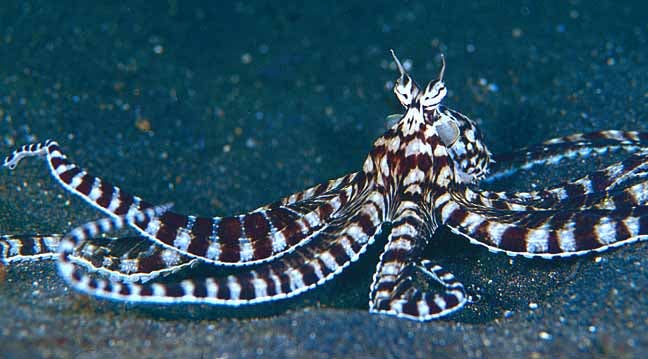
The mimic octopus, Thaumoctopus mimicus is a species of octopus that grows up to 60 cm (2 feet) in length and is naturally colored with brown and white stripes and spots. So what’s so special about it? The mimic octopus can literally mimic the physical appearance and movement of fifteen different species, that we know of (including, but not limited to sea snakes, lionfish, flatfish, brittle stars, giant crabs, sea shells, stingrays, flounders, jellyfish, sea anemones).
This fascinating creature wasn’t discovered until 11 years ago; after the first one was spotted, a relatively thorough research project was launched, and in the following two years, only 9 different such creatures were seen.
The mimic octopus is extremely intelligent and despite the fact that mimicry is quite a common trait in the animal world, Thaumoctopus mimicus is the only observed animal that can mimic multiple species. In fact, it’s so smart that it actually knows what animal is best to mimic. If it’s being a hunter, it knows exactly what animal the predator will fear and impersonates that one.
Here are some more exciting facts on the mimic octopus:
Here are some interesting facts about this unique octopus:
Masters of Disguise
- Camouflage Expert: Like other octopuses, the mimic octopus can change its skin color and texture to blend in with its surroundings. What sets it apart is its ability to mimic other marine animals.
Shape-shifters
- Amazing Mimicry: The mimic octopus can impersonate other animals like lionfish, flatfish, and even sea snakes by changing its body shape and movement patterns.
Habitat
- Sandy Bottoms: This octopus prefers the muddy and sandy bottoms of shallow waters, particularly in the Indo-Pacific region.
Impersonation for Survival
- Tactical Mimicry: The species it mimics are generally poisonous or venomous, which deters predators from attacking.
Diet
- Small but Mighty: Despite being relatively small, the mimic octopus has a varied diet that includes small fish, worms, and crustaceans.
Intelligence
- Smart Choices: The mimic octopus chooses which animal to impersonate based on the predator it’s trying to avoid. For example, it might mimic a sea snake when a damselfish is nearby, as damselfish are known to avoid sea snakes.
Limited Discoveries
- Newly Discovered: The mimic octopus was only officially discovered in 1998, making it a relatively new addition to the cephalopod family in scientific terms.






